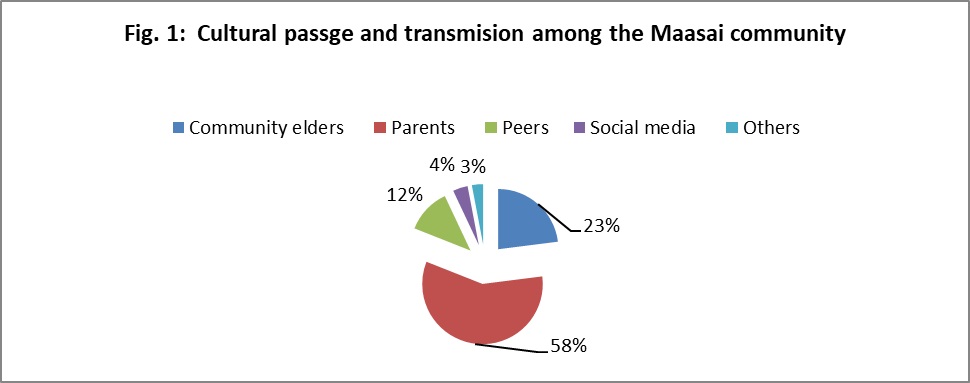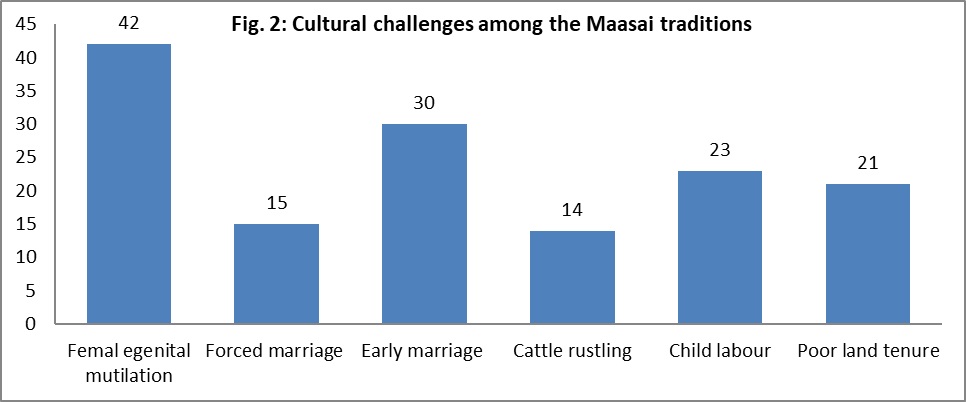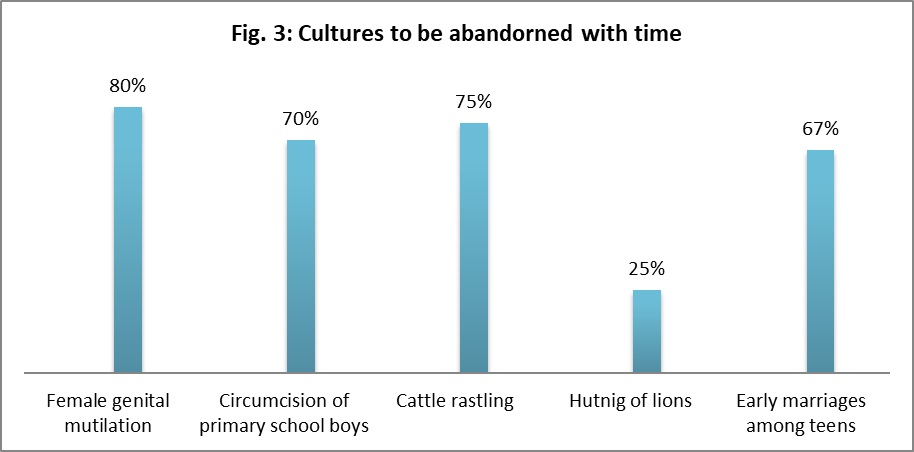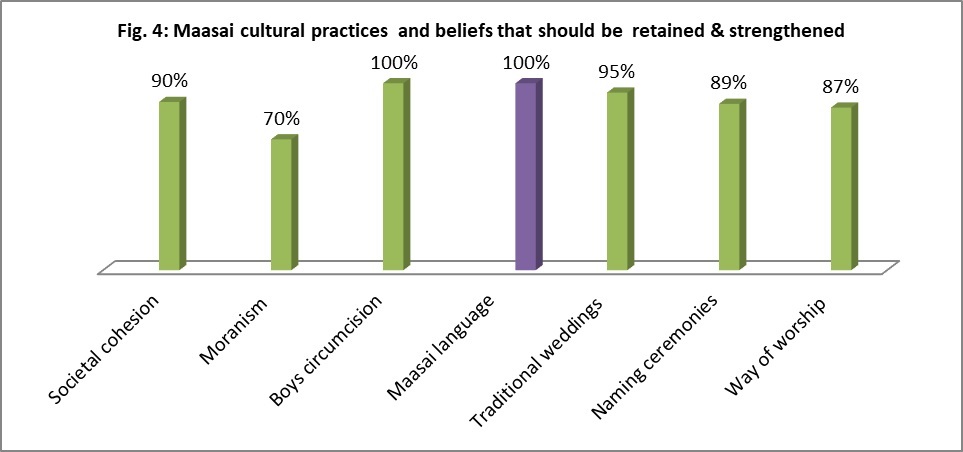The Traditional Beliefs Inhibiting Uptake of Education in Kajiado Community During the 21st Century
- Ibuathu C. Njati
- Ogachi Abel
- 540-547
- Apr 25, 2024
- Sociology
The Traditional Beliefs Inhibiting Uptake of Education in Kajiado Community During the 21st Century
Ibuathu C. Njati, Ogachi Abel
Meru University of Science & Technology
DOI: https://doi.org/10.51584/IJRIAS.2024.90348
Received: 05 March 2024; Revised: 17 March 2024; Accepted: 21 March 2024; Published: 25 April 2024
ABSTRACT
Are there particular cultures that are more adequate than others in the sense that they are perceived relevant during the 21st century of globalization? If so, which are the possible criteria to determine that certain cultures are adequate and have the power to change peoples’ identities? The study sought to address issues on traditional beliefs inhibiting uptake of education in Kajiado community during the 21st century. The objectives were to: establish cultural beliefs affecting education among the Kajiado community members and find out the youths’ attitude towards various cultural practices affecting their contemporary ways of life. The study used survey design with cluster random sampling yielding 90 participants who responded to questionnaires and interview schedules. Female genital mutilation (42%), early marriage (30%) and child labour (23%) were cited as the most retrogressive culture. The study concluded that sensitization of community members against negative cultural beliefs be done through public barazas, community-based organizations, churches, schools, local television and radio stations, socio media and print media platforms. It was recommended that Nyumba Kumi initiative monitor homes under their jurisdiction to prevent female genital mutilation practitioners and consumers of their services from taking place.
Key words: cultural beliefs, education, cultural practices, attitudes
INTRODUCTION
Traditional cultural practices reflect values and beliefs held by members of a community for periods often spanning generations. Every social grouping in the world has specific traditional cultural practices and beliefs, some of which are beneficial to all members while others are harmful to a specific group Bousinger argues that culture equals identity (Butler, and Fehr, 2021). The case of culture and identity go together inseparably. Thus, culture and identity are glued together like the cow and its skin. Are there particular cultures which are more adequate than others in the sense that they seem more relevant in an age of globalization? If so, what are the possible criteria to determine that certain cultures are adequate and have the power to change peoples’ identities? Moreover, it is a relevant question to ask whether it is within the individual’s decision to voluntarily select to be part of a particular culture that she or he prefers according to his/her criteria (Lauren, et. al, 2001).
For a number of years, many voices, both national and international, have been echoing the United Nations call for an end to the suffering of girls and women caused by harmful traditional practices. Lauren et. al, (2001) observed that in 1983, the Sub-Commission on Prevention of Discrimination and Protection of Minorities against female degrading practices took over and escalated these issues through out that period.
It recommended that a working group be established to conduct a study of all aspects of the problem that was endorsed by the Commission on Human Rights and the Economic and Social Council. The Working Group on Traditional Practices Affecting the Health of Women and Children, composed of experts designated by the Sub-Commission on Prevention of Discrimination and Protection of Minorities, UNICEF, UNESCO and WHO, and representatives of concerned NGOS. They held three sessions in Geneva during 1985 and 1986 that ratified and upheld the decisions against women and girls’ discriminations. Thirty years later, the SDGs asserted the rights of every child to education by eradicating illiteracy and facilitating equal access to education by all (ILO, 2018a and UN Women, 2018).
The Maasi transmit their cultural values and beliefs to their children mostly during teenage period. Subject matters taught include environmental studies, economics and other productive arts (Ronoh, 2008). The male Maasai youths are educated on the importance of being rich in livestock. The youths obtain skills for the maintenance and expansion and growth of wealth. The male adults are duty bound to instruct boys on ways of carrying out activities on indigenous knowledge and skills of rearing animals such as, identification of nutritious grass, herding and identifying various domestic animal diseases. Therefore, youths are taught elaborate training about all aspects of animal husbandry (Sena, 1986).
Study Objectives
- To find out cultural values and beliefs affecting education among the Kajiado community members.
- To establish the youths’ attitude towards various cultural practices affecting their contemporary ways of life.
LITERATURE REVIEW
It is now recognized that science and technology can no longer develop in isolation from cultural values as the influence they exert on a given society constitutes the most important element to be considered, but also the most difficult to pin-point (FitzGerald, 2008). With this in view, UNESCO has carried out major studies on the impact of science and technology on ethical and aesthetic values, ways of life or the social and cultural environment of societies, so as to contribute to the promotion of endogenous scientific and technological development. Therefore, the introduction of any new technology is perceived as a cultural phenomenon that has a direct or indirect effect on the living environment, the behaviour and the cultural values of societies. Furthermore, “technology” is not uncommonly presented as one of direct interaction with people’s cultural values, but it plays a pivotal role in influencing a community’s cultural transformations. On the one hand, Maasai Girls Educational Fund (2012) observes that cultural values are seen as a determining factor in the choice and impact of technology; on the other hand, technology is conceived as potentially transforming cultural values. This is particularly true of the analysis of the relationship between values and technology in traditional societies. In this type of analysis, it is often assumed that values determine social behavior (assumption of causality), that values form a coherent system shared by the whole of a given society (assumption of homogeneity) and that values constitute the core of culture and lend it creativity and capacity of resistance.
Kiringe (2006) asserts that the preliminary final reports of the Special Rapporteur on traditional practices affecting the health of women and children established that from 28 countries there were harmful traditional practices that were unknown in their countries. Others recognized the existence of some such practices, namely female genital mutilation (FGM), son preference and inferior social status of women, and practices related to marriage, pregnancy and nutrition. According to Doug (1990), Kwallah (1992) and Peachtree (2009) a number of countries throughout the world have either taken or supported action to prevent traditional practices affecting the health of women and children, in particular FGM. Bangladesh clearly upholds the principle of equality of men and women and prohibits discrimination against women. These studies continue to observe that to protect the legal rights of women and to stop violence and repression against them, the Government has adopted the following legislation:
(a) Dowry Prohibition Act, 1980, which provides for punishment for giving, taking or abetting the giving or taking of dowry.
(b) Cruelty to Women (Deterrent Punishment) Ordinance, 1983, which provides for punishment for abduction of women for unlawful purposes, trafficking in women, or causing or attempting to cause death or grievous harm to a wife for dowry.
(c) Child Marriage Restraint Act Amendment Ordinance, 1984, which rises the marriageable age for women from 16 to 18 years, and for men from 18 to 21 years. It also provides for punishment for marrying or giving in marriage of a child.
(d) Muslim Family Laws Ordinance, 1961 (as amended in 1982), which provides for increased punishment in cases of polygamy and divorce in violation of the statutory provisions. In the Sudan, a law was passed in 1946, under the British Colonial Administration, to prohibit these practices.
Stroebel (2004) and Fratkin (2001) aver that the United Nations Children’s Fund (UNICEF) has supported a wide range of programme activities for the advancement of women and girls through advocacy, policy-oriented research and technical cooperation. There are many examples in the sectors of health, education, income generation and water supply and sanitation of projects successfully addressing the needs of women and girls and promoting their participation in community development. Fratkin (2001) explains that in May 1994, UNICEF’s Executive Board requested the Executive Director to give high priority to a number of efforts to promote gender equality and gender-sensitive development programmes, taking into account the special needs of individual countries and, inter alia, the provisions of the Convention on the Rights of the Child and the Convention on the Elimination of All Forms of Discrimination against Women. Therefore, Government of Kenya (2005) and Hauff (2003) assert that the priorities for action include:
(a) Strengthening the integration of gender concerns in country programmes by eliminating the disparities which exist at each stage of the life cycle of girls and women.
(b) Promotion of ratification and implementation of the Convention on the Elimination of All Forms of Discrimination against Women, as well as the Convention on the Rights of the Child.
(c) Support for specific action and strategies which promote gender equality within the family, including the sharing of parental responsibilities.
UNICEF country offices are working closely with NGO partners and Governments, as well as with other groups, including women’s organizations, religious leaders, health workers and teachers to see to it that girls access education as well as boys among the Maasai community and other communities (Hodgson, 2001).
For a number of years, many voices, both national and international, have been echoing the United Nations call for an end to the suffering of girls and women caused by harmful traditional practices. In the 1980s, the campaign against such practices became so widespread that, in 1983, the issue was taken up by the Sub- Commission on Prevention of Discrimination and Protection of Minorities (Khazanov, 1984 and Stocking & Boaz, 1966). The Sub-Commission’s recommendation that a working group be established to conduct a study of all aspects of the problem was endorsed by the Commission on Human Rights and the Economic and Social Council. The Working Group on Traditional Practices Affecting the Health of Women and Children, composed of experts designated by the Sub-Commission on Prevention of Discrimination and Protection of Minorities, UNICEF, UNESCO and WHO, and representatives of concerned NGOS, held three sessions in Geneva during 1985 and 1986. The report of the Working Group (E/CN.4/1986/42) was submitted to the Commission on Human Rights at its forty-second session, in 1986 (Bee, Diyamett and Towo 2002). By its resolution 1988/57 of 9 March 1988, the Commission on Human Rights requested the Sub- Commission to consider measures to be taken at the national and international levels to eliminate the practices in question, and to report to the Commission on the subject. Pursuant to that request, the Sub- Commission appointed one of its members, Mrs. Halima Embarek Warzazi, as Special Rapporteur to study, on the basis of information to be gathered from Governments, specialized agencies, other intergovernmental organizations and concerned NGOS, recent developments relating to traditional practices affecting the health of women and children (UNPFII, 2005).
METHODOLOGY
A descriptive survey design using mixed method approach was used to study the Maasai cultural beliefs and values transmission among the community members. According to Kombo and Tromp (2006), a survey is used to gather data from a large number of samples at a particular time so as to describe the nature of the problem being investigated. The study adopted, a descriptive survey design to gather data from Kajiado residents to inform the ways cultural transmission affected education of their children during the 21st century. A random cluster sampling technique was used to pick a sample of 90 respondents including men women and youth in equal proportion to participate in the study. Interview schedules and questionnaires were used to collect data that was analyzed and presented in graphs, pie charts and percentages.
RESULTS AND DISCUSSIONS
Community Involvement in the Passage of Traditional Culture and Beliefs among the Kajiado Residents
A question on the specific areas of involving elders, parents and peers in the Maasai community in their daily duty of cultural involvement in the society was presented to the respondents. A greater percentage of respondents admitted that the cultural values and beliefs they follow as the community were passed on to them through their parents. This is carried out through observation and strong cultural initiations practices carried out in age groups, with severe penalties to the initiate who breaks a practice. The respondents were asked to identify the individuals from whom they enumerated the Maasai culture and practical beliefs. Their responses are presented in figure 1.
Majority of the respondents 58% presented in the pie chart said that parents were majorly the mentors of their children on cultural matters; followed by elders at 23% and peers at 12% and social media at a low of 4%.
The parents are the primary role models to their children at home from childhood to youthful stage of mid-teens. Therefore, their social cultural influence on their children is huge since the children are expected to observe and practice what they are taught in their daily activities by their role models. For example, girls are supposed to undergo female circumcision on attaining puberty stage. They now believe they are ready for womanhood and therefore are married of to go and start a family. Equally, the boys are taught to be hardy and once they are circumcised into a moran, meaning warrior they are supposed to be self-reliant. So, many leave school in search of livelihood. According to Whitaker (2013) individuals’ social roles are made up of beliefs about what one should do in given social contexts and the set of personal behaviors that are characteristically enacted are consistent with those beliefs, in those social contexts. This shows that parents are aware of their roles only that they may be limited in their provision by various challenges that are prevalent among the youths during the 21st century.
The Challenges Experienced by Youths in Observing the Maasai Traditional Way of Life Within Kajiado
The respondents presented in figure 2 were asked to identify cultural problems facing their society in the face of 21st century. Most respondents, 41% identified female genital mutilation, (FGM), early marriage at 31%, child labour 20% and poor land tenure 23% as the most retrogressive cultural factors negating the development of education in Kajiado besides the modern social media challenges influences on the youth. Thus, the girl child is not spared time to earn education but married off at during teenage. On the other hand, the community poor and tenure system has contributed to haphazard grazing of animals on the savanna grasslands with young boys attending to animals at the expense of their education. At the same time, due to poverty. 14% of the participants explained that there is cattle’s rustling that makes the environment volatile for schooling of their children. These factors negatively influence the education of Kajiado School going age children.
Youths Views of their Attitudes to Various Cultural Practices and the Modern Ways of Life
Sample youths provided their opinions on the cultural practices in their community with respect to modernization culture. Their views are presented in figure 3.
a). Views on attitude towards some Maasai traditional cultures
Majority, 80% of the respondents had negative attitude towards FGM cultural practices. They lamented that FGM should be stopped and abandoned immediately because it was hurting the girl child’s education as a way of progressive in life. In any case, FGM is a torture and only inhibits the girl from continuing with education since they are married of immediately after the FGM imitation.
Rustling of cattle was perceived by 75% of the respondents as negative belief and cultural practice that is has outlived its purpose. Many respondents said boys should be taught good manners and practices of earning wealth through completive clerical, manual works or engaging in productive business. In this respect Doreen & Linda (2010) agreed that some Maasai parents supported fully transmission of Maasai cultural values to the next generations while some others felt there was need to change with changing trends of modernization. Maybe, the most prevalent argument of cultural enhancement and loss surrounds female circumcision ceremonies with some parents supporting status quo while others felt that it would be abandoned through consensus.
b). Respondents’ positive attitude towards some cultural practices
Some respondents expressed positive attitude towards cultural practices and beliefs they felt could be retained and strengthened now and in future. Their options are presented in figure 4.
The respondents had positive attitude towards seven cultural beliefs and practices they perceived should be retained and strengthened, attracting 70% to 100% support of the informants as presented in figure 4. All the respondents supported circumcision of boys who are past primary education and Maasai language being retained and strengthened as a bond for community’s social pillar. Furthermore, 95% and 90% of the respondents perceived that Maasai traditional weeding’s and societal ceremonies should be retained. These serve as the community’s adhesion for social and moral fiber.
These observations are supported by Naomi (2019) who asserted that the Maasai’s love and praise their culture since it an economic source of wealth for their community. So, the youths must practice and protect it through legal means so as to enhance their cultural economic values from tourism.
CONCLUSION
The study concluded that a parent among the Maasai community of Kajiado County is the accelerator of traditional cultural values and beliefs to their children. Thus, parents played the critical roles in preparing their children for the community rites of passage.
It was asserted that FGM and girls early marriages attracted negative attitude among the residents since they were harmful cultural practices that impacted negatively on education of their children and therefore should be discouraged and avoided by all.
The respondents had positive attitude towards some good cultural practices and beliefs like community wedding ceremonies, circumcision of boys who are past primary school education and Maasai language. They fully supported these for retention and enhancement.
RECOMMENDATIONS
The study recommends that the Kajiado County community unite against bad cultural practices like FGM and rustling of cattle and seek government support in enforcing anti-FGM policy in their households. Such awareness campaigns could be sensitized to the public by local government administrators and politicians during public barazas, in women groups meetings and in prayer houses. The Nyumba Kumi initiative should ensure FGM circumcisers are not allowed to go with their harmful practices and be reported to police on the spot.
The cultural practices that enhance the community’s social and moral pillar like wedding ceremonies, local dialect among others should be supported so as structure and grow the values of the community like education institutions. It was recommended that Nyumba Kumi initiative monitor homes under their jurisdiction to prevent female genital mutilation practitioners and consumers of their services from taking place by reporting such occurences to the security enforcing officers.
REFERENCES
- Butler, Jeffrey Vincent and Fehr, Dietmar (2021) The Causal Effect of Cultural Identity on Cooperation. CESifo Working Paper No. 9032, Available at SSRN: https://ssrn.com/abstract=3832487or http://dx.doi.org/10.2139/ssrn.3832487
- Doreen E. M. and Linda M. W. (2010) My Child Will have Two Brains, One Maasai, One Educated: Negotiating Traditional Maasai Culture in a Globalized World. https://www.researchgate.net/publication/254095761 DOI: 10.1177/016059760603000404
- Hennink, M., Hutter, I., & Bailey, A. (2010). Qualitative Research Methods. Sage.
- Kombo, D. K., & Tromp, D. L. (2006). Proposal and thesis writing: An introduction. Nairobi: Paulines Publications Africa, 10-45.
- Lauren, K.B., Yadira, R. and Jennifer. M.H. (2001). Gender Equity, Gendered Roles and Reproductive Health. Canada, Tanzania: Maasai Women in Northern Tanzania University of Calgary, Endulen Hospital.
- Leleto, N. L. (2019). Maasai Resistance to Cultural Appropriation in Tourism; The Indigenous Peoples’ Journal of Law, Culture & Resistance, 5(1) PP (21-34) ISSN 2575-4270. DOI 10.5070/P651043046
- Ronoh. A.K. (2008). “Influence of Indigenous Knowledge on the Adoption of SchoolBased Education Among Kenyan Maasai: Implications for Curriculum Reform.” Unpublished Ph. D Thesis, Egerton University, Kenya.
- Sena, Ole, S (1986). Pastoralist and Education: School Participation and Social Change among the Maasai. Unpublished Ph. D Dissertation, McGill University, Montreal, Canada.
- Bee, F. K. Diyamett, M.L. Towo, E N (2002) Challenges to Traditional Livelihoods and
Newly Emerging Employment Patterns of Pastoralists in Tanzania. Geneva,
Switzerland: ILO - FitzGerald, R.S. (2008) The Last of the Maasai in Northern Tanzania? – Redefining
Cultural Identity. Master’s thesis for Art in Humanitarian and Development
UK: Oxford Brookes University. - Fratkin, E. (2001). East African Pastoralism in Transition: Maasai, Boran, and Rendille
African Studies Review, Vol. 44, No. 3 (Dec., 2001), pp. 1-25. African Studies Association. - Government of Kenya. (2005). Kajiado County Data Sheet. Kenya Open Data Initiative
- Hauff, E. (2003). The Effects of Development on the Maasai. USA: College of St.
Benedict/St. John’s University. - Hodgson, D. L. (2001). Once Intrepid Warriors: Gender, Ethnicity and the Cultural Politics of Maasai Development. Bloomington: Indiana University Press
- ILO (2018a). Ending violence and harassment in the world of work. Report V (2). ILO Geneva (Yellow Report)
- Joy, A. (1967). The Peoples of Kenya. Harcourt, New York: Brace & World, Inc.
- Kaplan, I. et al. (1967). Area Handbook for Kenya. (2nd ed).
- Khazanov, A. M. (1984). Nomads and the Outside World. Cambridge: Cambridge University Press.
- Kiringe, J.W. (2006). A Survey of Traditional Health Remedies Used by the Maasai of Southern Kajiado District, Kenya. Ethnobotany Research & Applications 4:061-073
- Kwallah, S. O. (1992). Cultural Aspect in Relation to Education. A paper presented to the3rd Conference on the Future of Maasai Pastoralists in Kajiado district. M.Ed. August, 1992.
- Maasai Girls Educational Fund. (2012). Dining for Womenhttp://www.africapoint.com/newsletters/maasai2.htm. Accessed on 12th April 2013.
- Moyo, B., Masika, P. J. (2009). Tick control methods used by resource limited farmers and the effect of ticks on cattle in rural areas of the Eastern Cape Province, South Trop. Anim. Health Prod. 41: 517-523.
- Peachtree. (2009). Cows and the Maasai. Peachtree Publishers
- Doug, Jr. P. (1990) Doing Theology with the Maasai. California: William Carey
- Sankan, S.S. (1995). The Maasai. Nairobi, Kenya: Kenya Literature Bureau.
- Secretariat of the Permanent Forum on Indigenous Issues (UNPFII). (2005). Background note prepared by the Secretariat of the Permanent Forum for the International Workshop on Traditional Knowledge. Panama City: 21- 23 September 2005. Doc.PFII/2005/WS.TK
- Stocking, G. W. & Boaz, F. (1966). The Culture Concept in Historic Perspective
Berkeley: University of California - Stroebel, A. (2004). Socio-Economic Complexities of Smallholder resource-Poor
Ruminant Livestock Production Systems in Sub-Saharan Africa. PHD Thesis, South
Africa: University of the Free State. - UN Women. (2018). Towards an End to Sexual Harassment: The Urgency and Nature of Change in the Era of #METOO. New York: UN Women.
- Whitaker, M. C. (2013). School Influences on Parents’ Role Beliefs. The Elementary School Journal · September 2013 DOI: 10.1086/671061




